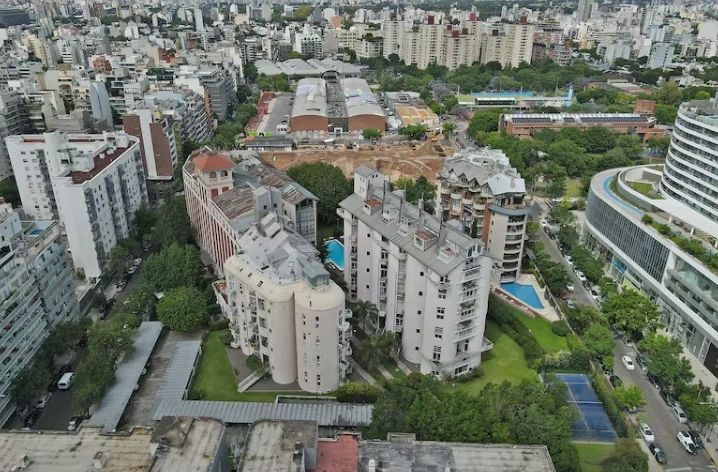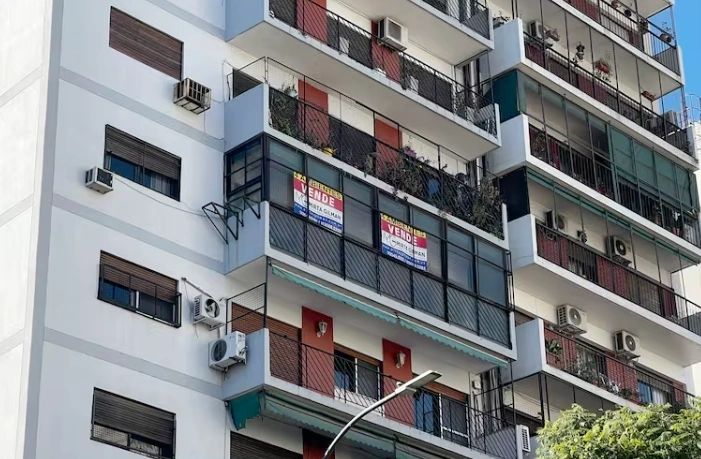BuySellBA
Administrator
Divisible mortgages and construction-property vouchers: What else is needed to make these two measures work? - La Nacion Propiedades

Source:

 www.lanacion.com.ar
www.lanacion.com.ar
August 01, 2025
The author welcomes the government's decisions but warns that they will only be effective if accompanied by a solid and coherent housing policy.
By Ivan Kerr

A reflection on the two new government measures aimed at boosting the real estate market and access to housing.
Recently, the Government, through Joint Resolution 2/2025 of the Ministries of Economy and Justice, which regulates the operation of divisible mortgages , and Technical Registry Provision 11/2025, which enables the registration of purchase agreements for units under construction in the City of Buenos Aires , once again put forward two fundamental tools for unblocking access to credit and reducing the housing shortage . We celebrate and comment on them below.
The regulations represent a successful regulatory advancement of Decree 1017/2024, issued in November of last year, which implemented measures aimed at stimulating the development of the mortgage loan market and thus seeking to expand financing for first-time homeowners .
As someone who actively participated in the debate over Decree 962/2018, which allowed for the registration of deeds of sale, I welcome the recognition of the problem, but I caution that these measures will only have an impact if they are part of a solid and coherent housing policy.

The former Secretary of Housing reflects on two key tools for unlocking access to credit and reducing the housing shortage. Ricardo Pristupluk
The new Resolution 2/2025 resumes this path with a more ambitious objective: to allow a real estate project to establish a "global" mortgage that can then be divided when it affects horizontal property or real estate complexes . The regulation explains that divisible mortgages can be established from the project's constitutive deed and that, once the property is subdivided, the credit and guarantee can be divided proportionally, and even the flows can be securitized. The Government defends the measure by arguing that the lack of divisible mortgages reduced the supply of mortgageable housing and limited the financing of future projects, which is entirely correct.
At the same time, Provision 11/2025 regulates the registration of purchase agreements for units under construction in Buenos Aires City and imposes requirements: the agreements must be identified with the parties' information, specify the project and the unit, provide proof of a minimum down payment (the decree requires a deposit of at least 25% of the price), and be certified by a professional. The idea is to provide legal certainty and pave the way for divisible mortgages.
These tools are valuable because they allow for integrated financing of construction and purchases. In a November 2024 column for the newspaper LA NACION , I emphasized that, in contrast to Decrees 1017 and 1018/2024, mortgage loans must be the primary tool of housing policy . In that article, I emphasized that in Argentina, with a mortgage stock of less than 1% of GDP, construction is financed through the pre-sale of units "in progress" through trusts. This scheme only works for those with dollars saved , excluding the vast majority of families in our country. That is why I insisted that we must pass laws such as Peru's mortgage for future good or Uruguay's deedable promise of sale , which facilitate access for families and finance large-scale real estate projects.

"Mortgage loans should be the primary tool of housing policy," says Iván Kerr. Daniel Basualdo
Divisible mortgages on surface or future real estate rights are excellent tools for financing more ventures , bringing mortgage credit closer to the bottom line and lowering costs, creating a market for "credit-worthy" units that doesn't exist today.
But should we also ask ourselves whether these regulations are sufficient? To answer this question, it's necessary to place the new tools in the current context, where, since 2017, the construction cost index measured by the Argentine Chamber of Construction (CAC) has multiplied by 95, well above general inflation. Furthermore, according to a report by the Tejido Urbano Foundation, more than 40% of construction companies in 2025 declared they would not take out credit , an increase of 15 points compared to the average between 2018 and 2023.
Given this scenario, it's logical that the lack of financing restricts supply and increases prices. The housing shortage is reflected in households: in 2024, also according to Tejido Urbano, some 2,265,000 young people aged 25 to 35 lived with their parents or grandparents , 36.7% of that age group. This data clearly shows that there is a generation postponing independence because they cannot access credit or stable rent.
In this sense, it's important to emphasize that divisible mortgages can be a powerful tool if used correctly. This is because they facilitate access to financing for families to purchase new homes, while also enabling construction financing for real estate projects from the outset. Buying from the start reduces the cost of the property by approximately 30% .

There is a generation that is postponing independence because they cannot access credit or stable rent.JJ-stockstudio - Shutterstock
The road ahead is long; the measures aim to stimulate the development of the mortgage loan market, a key tool for combating the housing shortage. However, this also requires a stable economy, low inflation, and a financial system willing to provide long-term lending. This expansion can only be achieved with greater capital market participation.
Here I return to a concept I've championed since my time at the Ministry of Housing: "Structure follows strategy." This means that specific regulations are necessary, but without an active housing policy, robust institutions, and stable financing, they become mere patches. In 2024, according to a report by the Tejido Urbano Foundation, which compiled data from financial institutions and the Central Bank, Argentina granted approximately 11,000 mortgage loans. This number is minimal; it represented just 0.2% of the gross domestic product, a level well below regional standards, and many families still cannot afford to buy their homes.
Therefore, if we focus solely on individual credit without supporting it with subsidies and urban land development programs, we will continue to see a segmented market that fails to meet the shortfall in demand. In many countries in the region, housing policy combines access to mortgage credit with progressive subsidies and pre-saving or guarantee fund programs , which allow for scaling up supply and serving diverse income groups.
Likewise, we cannot ignore the closure of the Housing Secretariat and the dismantling of programs for access to first homes that the current government announced at the end of 2024. This represents a relinquishment by the State as a governing body in this matter.
Recent resolutions are on the right track, but the elimination of specialized institutions reduces the capacity to coordinate land, infrastructure, credit, subsidies, and savings . We need a housing authority that plans for the long term, coordinates with provinces and municipalities, and ensures that tools, such as divisible mortgages, are not left solely in the hands of a volatile market.
In short, Resolution 2/2025 and Provision 11/2025 provide improvements, and divisible mortgages are an excellent tool for financing projects and creating a market for credit-eligible units . However, for these measures to truly facilitate access to housing, it is urgent to reestablish an institutional structure dedicated to housing and habitat, because thousands of young people will continue to live with their parents and millions of families will remain in the informal sector if the problem is not comprehensively addressed . The opportunity is on the table; it is up to everyone to turn these regulations into a true path to homeownership.
www.buysellba.com
Source:
Hipotecas divisibles y boletos de propiedades en construcción: ¿qué más hace falta para que estas dos medidas funcionen?
El autor celebra las decisiones del Gobierno pero advierte que solo serán efectivas si están acompañadas de una política de vivienda sólida y coherente
August 01, 2025
The author welcomes the government's decisions but warns that they will only be effective if accompanied by a solid and coherent housing policy.
By Ivan Kerr

A reflection on the two new government measures aimed at boosting the real estate market and access to housing.
Recently, the Government, through Joint Resolution 2/2025 of the Ministries of Economy and Justice, which regulates the operation of divisible mortgages , and Technical Registry Provision 11/2025, which enables the registration of purchase agreements for units under construction in the City of Buenos Aires , once again put forward two fundamental tools for unblocking access to credit and reducing the housing shortage . We celebrate and comment on them below.
The regulations represent a successful regulatory advancement of Decree 1017/2024, issued in November of last year, which implemented measures aimed at stimulating the development of the mortgage loan market and thus seeking to expand financing for first-time homeowners .
As someone who actively participated in the debate over Decree 962/2018, which allowed for the registration of deeds of sale, I welcome the recognition of the problem, but I caution that these measures will only have an impact if they are part of a solid and coherent housing policy.

The former Secretary of Housing reflects on two key tools for unlocking access to credit and reducing the housing shortage. Ricardo Pristupluk
The new Resolution 2/2025 resumes this path with a more ambitious objective: to allow a real estate project to establish a "global" mortgage that can then be divided when it affects horizontal property or real estate complexes . The regulation explains that divisible mortgages can be established from the project's constitutive deed and that, once the property is subdivided, the credit and guarantee can be divided proportionally, and even the flows can be securitized. The Government defends the measure by arguing that the lack of divisible mortgages reduced the supply of mortgageable housing and limited the financing of future projects, which is entirely correct.
At the same time, Provision 11/2025 regulates the registration of purchase agreements for units under construction in Buenos Aires City and imposes requirements: the agreements must be identified with the parties' information, specify the project and the unit, provide proof of a minimum down payment (the decree requires a deposit of at least 25% of the price), and be certified by a professional. The idea is to provide legal certainty and pave the way for divisible mortgages.
These tools are valuable because they allow for integrated financing of construction and purchases. In a November 2024 column for the newspaper LA NACION , I emphasized that, in contrast to Decrees 1017 and 1018/2024, mortgage loans must be the primary tool of housing policy . In that article, I emphasized that in Argentina, with a mortgage stock of less than 1% of GDP, construction is financed through the pre-sale of units "in progress" through trusts. This scheme only works for those with dollars saved , excluding the vast majority of families in our country. That is why I insisted that we must pass laws such as Peru's mortgage for future good or Uruguay's deedable promise of sale , which facilitate access for families and finance large-scale real estate projects.

"Mortgage loans should be the primary tool of housing policy," says Iván Kerr. Daniel Basualdo
Divisible mortgages on surface or future real estate rights are excellent tools for financing more ventures , bringing mortgage credit closer to the bottom line and lowering costs, creating a market for "credit-worthy" units that doesn't exist today.
But should we also ask ourselves whether these regulations are sufficient? To answer this question, it's necessary to place the new tools in the current context, where, since 2017, the construction cost index measured by the Argentine Chamber of Construction (CAC) has multiplied by 95, well above general inflation. Furthermore, according to a report by the Tejido Urbano Foundation, more than 40% of construction companies in 2025 declared they would not take out credit , an increase of 15 points compared to the average between 2018 and 2023.
Given this scenario, it's logical that the lack of financing restricts supply and increases prices. The housing shortage is reflected in households: in 2024, also according to Tejido Urbano, some 2,265,000 young people aged 25 to 35 lived with their parents or grandparents , 36.7% of that age group. This data clearly shows that there is a generation postponing independence because they cannot access credit or stable rent.
In this sense, it's important to emphasize that divisible mortgages can be a powerful tool if used correctly. This is because they facilitate access to financing for families to purchase new homes, while also enabling construction financing for real estate projects from the outset. Buying from the start reduces the cost of the property by approximately 30% .

There is a generation that is postponing independence because they cannot access credit or stable rent.JJ-stockstudio - Shutterstock
The road ahead is long; the measures aim to stimulate the development of the mortgage loan market, a key tool for combating the housing shortage. However, this also requires a stable economy, low inflation, and a financial system willing to provide long-term lending. This expansion can only be achieved with greater capital market participation.
Here I return to a concept I've championed since my time at the Ministry of Housing: "Structure follows strategy." This means that specific regulations are necessary, but without an active housing policy, robust institutions, and stable financing, they become mere patches. In 2024, according to a report by the Tejido Urbano Foundation, which compiled data from financial institutions and the Central Bank, Argentina granted approximately 11,000 mortgage loans. This number is minimal; it represented just 0.2% of the gross domestic product, a level well below regional standards, and many families still cannot afford to buy their homes.
Therefore, if we focus solely on individual credit without supporting it with subsidies and urban land development programs, we will continue to see a segmented market that fails to meet the shortfall in demand. In many countries in the region, housing policy combines access to mortgage credit with progressive subsidies and pre-saving or guarantee fund programs , which allow for scaling up supply and serving diverse income groups.
Likewise, we cannot ignore the closure of the Housing Secretariat and the dismantling of programs for access to first homes that the current government announced at the end of 2024. This represents a relinquishment by the State as a governing body in this matter.
Recent resolutions are on the right track, but the elimination of specialized institutions reduces the capacity to coordinate land, infrastructure, credit, subsidies, and savings . We need a housing authority that plans for the long term, coordinates with provinces and municipalities, and ensures that tools, such as divisible mortgages, are not left solely in the hands of a volatile market.
In short, Resolution 2/2025 and Provision 11/2025 provide improvements, and divisible mortgages are an excellent tool for financing projects and creating a market for credit-eligible units . However, for these measures to truly facilitate access to housing, it is urgent to reestablish an institutional structure dedicated to housing and habitat, because thousands of young people will continue to live with their parents and millions of families will remain in the informal sector if the problem is not comprehensively addressed . The opportunity is on the table; it is up to everyone to turn these regulations into a true path to homeownership.
www.buysellba.com

